 W
WChinese clothing describes both the ancient hanfu and modern variations of indigenous Chinese dress as recorded by the artifacts and traditional arts of Chinese culture. Chinese clothing has been shaped through its dynastic traditions, as well as through foreign influences. Chinese clothing showcases the traditional fashion sensibilities of Chinese culture traditions and forms one of the major cultural facets of Chinese civilization.
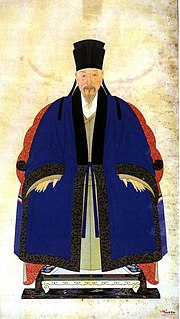 W
WA beizi (褙子) is an item of traditional Chinese attire common to both men and women; it is typically a large loose outer coat with loose and long sleeves. It was most popular during the Song Dynasty and Ming Dynasty. The beizi originated in the Song dynasty. In the Ming dynasty, the beizi was referred as pifeng (披风).
 W
WChang-ao is the historical Chinese attire for women. It is a form of formal wear, and is often perceived as a longer version of ruqun. However, it was actually developed from zhiduo during the Ming Dynasty, and is worn over a skirt. It is wide-sleeved, shorter than zhiduo and has no side panels (暗擺) at the side slits. There is often an optional detachable protective huling sewn to the collar. The huling can be of white or any other dark colours. The collar is of the same colour as the clothing.
 W
WA changshan is a traditional Chinese dress worn by men. In function, it is considered the male equivalent of the women's cheongsam (qipao). It is also known as a changpao or dagua. It was often worn by men with a magua or "riding jacket". These types of dress were widely adopted beginning under the Manchu rulers of the Qing dynasty, who required that men in certain positions wear this style.
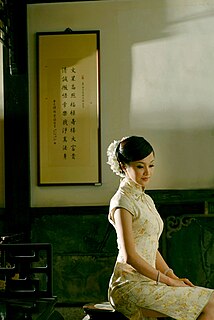 W
WThe cheongsam, also known as the qipao, is a type of body-hugging dress of Manchu origin. It is a high-necked, closefitting dress with the skirt slit partway up the side. It was known as the mandarin gown during the 1920s and 1930s, when it was modernized by Chinese socialites and upper-class women in Shanghai.
 W
WThe academic dress of China has a long history. The ancient dress is based on the robes of officialdom and the 'degrees' were earned through the imperial civil service examinations, while the modern dress is partially influenced by the Western academic dress. Ancient China consisted of official dress. Official dress was used to represent an official in society and a scholar at the same time.
 W
WThe Daopao, also called De Luo (得罗), is a traditional Chinese garment worn by men. The daopao was made popular as formal wear in Ming Dynasty China, though its origin from before this period is debated. Its name literally means "Taoist robe"; however, the daopao were and is worn by all men, regardless of religious background. It also continues to be worn by modern taoist priests.
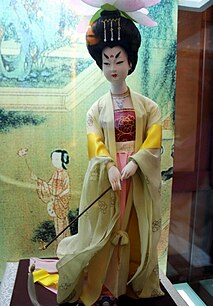 W
WDaxiushan (大袖衫), translated as "Large Sleeve Gown", is a traditional Chinese article of clothing for women and was most popular during the Tang Dynasty, particularly amongst the Royals. After the golden age of the Tang Dynasty ended, the influence of Hufu (胡服), or clothing styles from Central and Western Asia, gradually weakened and Tang royal women's clothing styles began to make their transformation. It was not until the Mid-Late Tang period (中晚唐时期) that the distinctions between Royal women's clothing and other styles became increasingly obvious. The width of the coat increased to more than four feet and its sleeves were often wider than 1.3 metres. It features a distinctive gown that covers the body from the ground to just above the chest with a knot wrapped around the waist, a light and sometimes sheer outer coat that ties together at the bottom, near the knees, and often goes along with a long scarf draped around the arms. The clothing often only covers half of women's breast and so it is restricted to women of a certain status, such as princesses or gējī. It has come to be known as Da-Xiu-Shan but has also been called Dian-Chai-Li-Yi (钿钗礼衣) at various times. The clothing was mainly worn for special ceremonial occasions and had different variations, mainly the result of different collar formations.
 W
WHuidi-yi (褘翟衣) is the historical Chinese attire worn by empresses and crown princesses in the Ming Dynasty. It is a formal wear meant only for ceremonial purposes. It is a form of shenyi, and is embroidered with long-tail pheasants and circular flowers (小輪花). It is worn with phoenix crown. Diyi has been worn by empresses and other royal noblewomen since the Zhou Dynasty under various names like huiyi (褘衣) in Zhou and Song Dynasty, and miaofu (庙服) in Han Dynasty.
 W
WA dudou is a traditional Chinese form of the bodice, originally worn as an undershirt with medicinal properties. With the opening of China, it is sometimes encountered in Western and modern Chinese fashion as a sleeveless shirt and backless halter-top blouse.
 W
WFengguan is a traditional type of Chinese headgear for women. It was worn mainly by noblewomen for ceremonies or official occasions. It is also traditional headgear for brides.
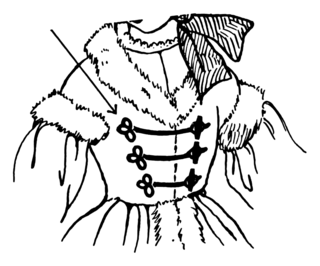 W
WA frog fastener is an ornamental braiding, consisting of a button and a loop, for fastening the front of a garment. The purpose of frog fasteners is to provide a decorative closure for a garment; frog fasteners are usual to garments of Asian design, such as a shirt or coat with a mandarin collar, which features frog fasteners at the shoulder and down the front of the garment. In the design of a garment, frogging is the use of braided, frog fasteners is a detail of the overall design of the garment.
 W
WHanfu is a term used for the historical styles of clothing worn by the Han people in China. In modern times, the term "hanfu" (汉服) was coined by Chinese Internet users to broadly describe ancient Han Chinese people's clothing worn before the Qing dynasty. There are several representative styles of Hanfu, such as the ruqun, the aoqun, the beizi and the shenyi. Traditionally, the hanfu consisted of a robe, or a jacket worn as the upper garment with a skirt commonly worn as the lower garment. In addition to clothing, hanfu also includes several forms of accessories, such as headwear, footwear, belts, jewellery such as yupei and handheld fans. Nowadays, hanfu is gaining recognition as the traditional clothing of the Han ethnic group and has experienced a growing fashion revival among young Han Chinese people in China and in the overseas Chinese diaspora.
 W
WThe hanfu movement, also known as Hanfu revival movement, is a subculture and cultural movement seeking to revitalize pre-Qing dynasty Han Chinese fashion that developed in China at the beginning of the 21st century.
 W
WKāṣāya are the robes of fully ordained Buddhist monks and nuns, named after a brown or saffron dye. In Sanskrit and Pali, these robes are also given the more general term cīvara, which references the robes without regard to color.
 W
WThe magua was a style of jacket worn by males during the Chinese Qing dynasty (1644–1911), designed to be worn together with and over the manshi changshan (滿式長衫). Magua is at waist length, with five disc buttons on the front and slightly short, wide sleeves. The garment was available in a number of styles: singlet, clip, leather, cotton yarn quilted and others. It was worn by Manchu people throughout China from the reign of the Qing Shunzhi Emperor until the time of the Kangxi Emperor,, whence it became popular throughout Qing China.
 W
WA mandarin collar, standing collar, band collar or choker collar is a short unfolded stand-up collar style on a shirt or jacket. The style derives its Western name from the mandarin bureaucrats in Qing-era China that employed it as part of their uniform.
 W
WA mandarin square, also known as a rank badge, was a large embroidered badge sewn onto the surcoat of an official in Imperial China, Korea, Vietnam, and the Ryukyu Kingdom. It was embroidered with detailed, colourful animal or bird insignia indicating the rank of the official wearing it.
 W
WThe modern Chinese tunic suit is a style of male attire originally known in China as the Zhongshan suit after the republican leader Sun Yat-sen. Sun Yat-sen introduced the style shortly after the founding of the Republic of China (1912-1949) as a form of national dress with distinct political overtones. The four pockets are said to represent the Four Virtues of propriety, justice, honesty, and shame; and the five buttons the branches of China's government.
 W
WMianfu, literally means "Coronation Costume", is a kind of Chinese clothing worn by emperors, princes and kings during imperial China, from the Shang Dynasty until Ming Dynasty.
 W
WNankeen is a kind of pale yellowish cloth originally made in Nanjing, China from a yellow variety of cotton, but subsequently manufactured from ordinary cotton that is then dyed.
 W
WOpen-crotch pants, also known as open-crotch trousers or split pants, are worn by toddlers throughout mainland China. Often made of thick fabric, they are designed with either an unsewn seam over the buttocks and crotch or a hole over the central buttocks. Both allow children to urinate and defecate without the pants being lowered. The child simply squats, or is held by the parent, eliminating the need for diapers. The sight of the partially exposed buttocks of kaidangku-clad children in public places frequently astonishes foreign visitors, who often photograph them; they have been described as being "as much a sign of China as Chairman Mao's portrait looming over Tiananmen Square."
 W
WPagri, sometimes also transliterated as pagari, is the term for turban used in the 'Indian subcontinent. It specifically refers to a headdress that is worn by men and women, which needs to be manually tied. Other names include sapho.
 W
WLanshan (襴衫) is the traditional Chinese attire for men. It is a formal attire worn by scholars and students (生員) taking the imperial examination in Ming Dynasty. It is wide sleeved, has black edges, and has a round collar secured with a button. A crossed-collar undergarment must be worn beneath it. It may or may not have side slits.
 W
WThe hu is a flat scepter of Chinese origin. It is also currently or was historically used in Japan, Korea, Vietnam and Ryukyu. It is known as the shaku in Japan, and is worn as part of the sokutai ceremonial outfit.
 W
WShen Shou was a Chinese embroiderer during the late Qing and early Republican period. She was pivotal in transforming embroidery from a feminine pastime into a craft that provided for women workers and their families. She created a signature style that combined traditional techniques with international taste and subjects and brought Chinese embroidery into modernity. Later in life, she established herself as a master in arts and crafts education and practices.
 W
WShenyi literally means "wrapping the body deep within the clothes" or "to wrap the body deep within cloth".
 W
WSwallow-tailed Hems and Flying Ribbons clothing, or tsa-chü chui-shao fu, or zaju chuishao fu is a type of female historical dress which was popular during the Cao Wei, Jin and Northern and Southern dynasties. It is also called Guyi or Kui-i (袿衣).
 W
WA tangzhuang (唐裝) is a kind of Chinese jacket with a straight collar. It is an updated form of the Qing magua, itself a more fashionable adaptation of the riding jacket once worn by Manchu horsemen.
 W
WIn Chinese opera, water sleeves refer to white silk extensions to the cuff of garment sleeves. They are worn by both male and female characters of the higher social class. They are so named because performers can use them to produce movements like the ripples of water.
 W
WIn China, women had different kinds of clothes in ancient times. Those clothes changed with the dynasty. For examples, in the 1920s, the Cheongsam was fashionable among socialites and upperclass women; during the 1960s, very austere clothing styles were prevalent; today, a wide variety of fashions are worn. Different provinces and regions of China also have different clothing styles.
 W
WYuanlingshan (圓領衫), also known as Yuanlingpao (圓領袍), is a form of traditional Chinese attire. It is a formal attire worn by men.
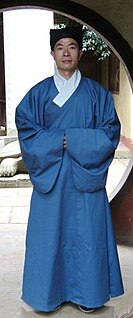 W
WZhiduo, also called zhishen (直身), refers to two traditional Chinese man's robes: casual zhiduo and priests’ zhiduo, in the broad sense. Particularly the former in the narrow sense.